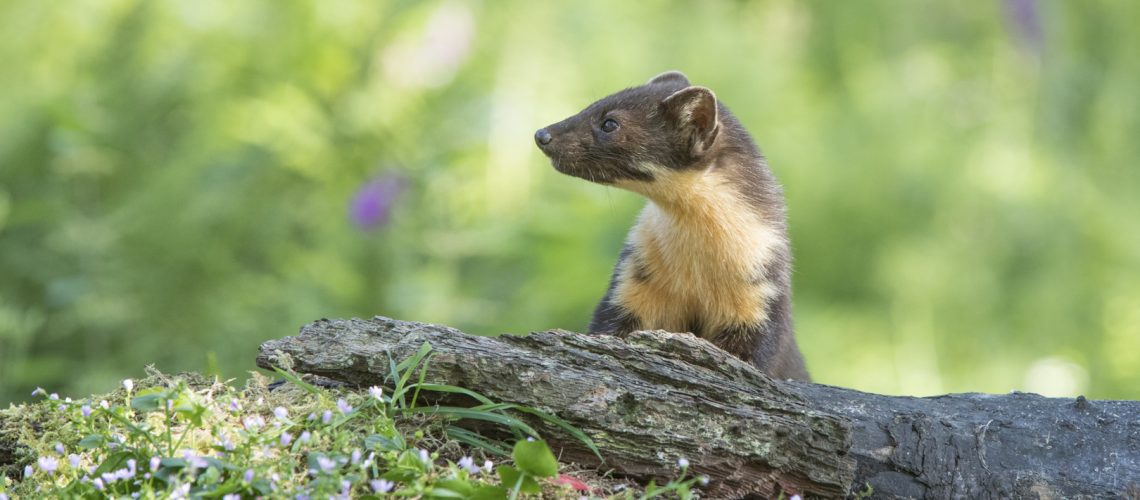
A decade-long conservation project to restore the fortunes of pine martens across Britain has hit a major milestone with more than 100 animals successfully translocated, re-establishing populations of pine martens in Wales and parts of southwest England.
The transformative collaboration between Vincent Wildlife Trust (VWT) and Forestry and Land Scotland (FLS), has seen pine martens from FLS forests boost populations in Wales, Gloucestershire and Devon. As a key part of forest ecosystems, the return of pine martens to Wales, Gloucestershire and Devon is a positive result for native wildlife and biodiversity.
Dr. Jenny MacPherson, Principal Scientist at Vincent Wildlife Trust, said:
“This partnership has been hugely beneficial, not just for pine martens but for the wider conservation landscape.
“Pine martens were once on the brink of extinction in England and Wales because of habitat loss and historical persecution. The concerted effort that has driven this pioneering conservation partnership has re-established and strengthened populations in parts of Britain and helped provide renewed security for these amazing animals.
“The commitment from Forestry and Land Scotland, as well as the support from communities in each region, has been invaluable. This project shows how collaboration can drive tangible conservation successes.”
Since work first began to establish the feasibility of translocations in 2014, VWT and FLS have worked together to identify healthy, thriving populations from forests across Scotland that could provide animals to create sustainable populations in previously depleted regions. The first translocation of pine martens in Wales happened in 2015.
The re-established populations in Wales and England have successfully bred each year and have increased in numbers and are spreading beyond the initial release sites. Pine martens have now returned to many counties across Wales and the English border counties resulting in a resilient western metapopulation.

Welsh pine marten ©Jason Hornblow
Kenny Kortland, Wildlife Ecologist at Forestry and Land Scotland, said:
“We have a long tradition of conservation work that benefits endangered species in Scotland, and we are happy to help others enhance biodiversity in other parts of Britain. By restoring missing species, we improve the ecological health and resilience of our forests.
“Working in partnership can often be a fundamental element of any ambitious programme like this and reaching the milestone of translocating 100 pine martens in a decade is a fantastic example of what can be achieved through dedicated partnership and science-led conservation.”
The VWT team carefully oversaw each translocation, ensuring the pine martens were safely and ethically captured, handled and transported under licence from NatureScot.
Health assessments, radio and GPS tracking, and post-release monitoring have been pivotal in ensuring that each translocated pine marten could adapt and thrive in its new home. Local communities and stakeholders in each region were also engaged in the process, fostering a shared sense of responsibility and excitement about this restoration effort.
Reintroductions in England were carried out in collaboration with Gloucestershire Wildlife Trust, Forestry England and the Two Moors Partnership.
Ed Parr-Ferris, Conservation Manager with Devon Wildlife Trust of the Two Moors Partnership, said:
“Working with VWT and FLS to translocate pine martens from Scotland to Devon this year has significantly strengthened biodiversity at the release sites.
“The success of this effort and what it has achieved is testament to the dedication of conservation organisations, government bodies, and local communities working together to restore and safeguard biodiversity for future generations.”
With more than 100 pine martens now successfully translocated, VWT and FLS are looking towards the next decade with ambitions to help the newly established populations, as well as those in Scotland, to increase and expand their range.
Plans include ongoing monitoring to ensure the stability of these populations and further community engagement initiatives to enhance understanding and support for pine marten conservation across Britain.
Main photo: Scottish pine marten ©Robert Cruickshanks